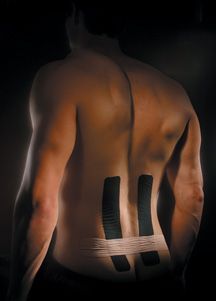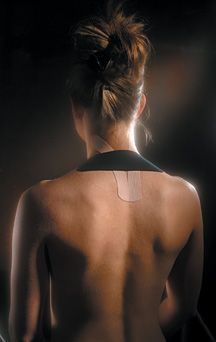On Oct. 21, 2025, a judge in Florida issued a groundbreaking decision in Complete Care v State Farm, 25-CA-1063. It concerns a fact pattern that many chiropractic doctors have faced wherein an insurer, such as State Farm or Allstate, decides to simply stop paying all claims submitted by a healthcare provider.
| Digital ExclusiveElastic Therapeutic Taping: A Valuable Fit for Chiropractic
The concept of elastic therapeutic taping first came to me in the 1970s while I was practicing as a chiropractor and teaching. The taping is non-invasive, free from drugs, and integrates well into the chiropractic model. Many conditions, including whiplash, herniated disc, muscle strain and sprain, headaches and degenerative joint disease are commonly treated with therapeutic taping in conjunction with traditional chiropractic.
Tracy Barnes, DC, DICCP, of Louisville, Ky., uses elastic therapeutic taping on many different kinds of patients. She enumerates: "For all those patients who continue to need a tactile cue to stay in certain postural positions, tape is great. For all those patients in pain from swelling, inflammation and injury, tape is great. For those patients who just need an extra 'umph' to feel better, tape is perfect." In fact, Barnes notes, "I wouldn't want to practice for long without it."
For many DCs, it is a standard in their practice. Dr. Scott Hainz practices in Missouri. He notes, "To help prevent prolonged recovery times, we incorporate [therapeutic taping] to enhance the in-office treatment, whether it be an adjustment or soft-tissue therapy."
Michigan chiropractor Dr. Tim Dunne observes that "Taping allows the patient to leave with a prescription for the body to follow through with as it heals in the proper functional motion. This leads to a significant increase in patient outcomes." Chiropractic is based on the knowledge that the human body has an innate self-healing ability and seeks balance. Therapeutic taping is based on the same assumption. Taken together, the whole concept is grounded in treating the cause of the patient's pain or weakness. In his experience, Dr. Dunne says, taping "always works." He has found that "if you are not getting the results you are looking for, reassess and retape; you haven't figured out the problem."
In the 1970s, it had became clear that the patient's response to treatment was the most important aspect of medicine. For example, allopathic practitioners received respect because they were able to implement pharmaceutical drugs with demonstrated effectiveness. While chiropractic adjustments have also been demonstrated to be effective, patients who are seeking pain relief may have a tendency to gravitate toward pharmaceutical treatments.
For this reason, it is important to search for the cause of the pain in order to treat patients more effectively using chiropractic techniques. The sensory receptors in the dermis turn out to be the key: upon specific stimulation of these receptors, which are plentiful in the skin, pain signals can be generated. Because of the abundance of these receptors, a cut or burn on the skin will hurt more than visceral pain. With this in mind, I considered how to best approach the management of painful conditions.

When we feel pain, we have a tendency to touch the area; however, it is not the application of pressure to the site, but the action of lifting with the palm of the hand that affects the sensation of pain. The lifting motion stimulates the mechanoreceptors in that particular region and decreases the pressure on the site, thereby decreasing the feeling of pain. Accordingly, I wanted to create a material that would simulate this action. At first, I was using athletic tape in an effort to avoid applying pressure to the painful site, but found that athletic taping was too constricting. This compression is helpful in stabilizing the area; however, it limits motion and circulation, and is consequently ineffective in managing pain. To solve this problem, I designed a unique elastic therapeutic tape. This creation allows for therapeutic taping treatment that does not involve drugs or surgery and is easily assimilated into common chiropractic protocol.
Studies have demonstrated the effectiveness of therapeutic taping for pain. A 2005 case study followed three patients who complained of patellofemoral pain and documented positive outcomes for all three. Patient #1, a 91-year-old woman, had improvements of "no pain with gait; no night pain, knee pain was immediately resolved following the application." For patient #2, age 56, treatment resulted in "no pain with normal walking, no pain with ascend or descend stairs." This patient also reported less pain at the end of her day. After treatment, 12-year-old patient #3 experienced no pain with running or during athletic activities such as running and snowboarding.

In a United Kingdom study yet to be released, South African MDs compared the use of ibuprofen versus elastic therapeutic taping for pain. Their results found the taping to be as effective as ibuprofen.
My own education is not only in spinal manipulation, but also includes training and experience with acupuncture, topical herbs, applied kinesiology and electrostimulation, among other modalities. Taking these into consideration, it is clear that the concept behind them all correlates with the way tissues need to be addressed.
Since being a chiropractic student, I have also been interested in the osteopathic fluid system and how this affects the body. Between the epidermis and the dermis lies the fluid lymphatic layer which has a close relationship with the capillary beds and often becomes congested. One can affect this layer by utilizing the hydrokinetic system: by creating more space and increasing the amount of fluid in that area. A secondary effect is an increase in circulation of the fluid. Third, there is a pumping effect propelled by the movements of the body. The movement of the cerebrospinal fluid (CSF) circulation has a pumping muscle at the base of its motion. Hence, a wasted, weak muscle can form a blockage to the movement of the fluid system in the body.
A Colorado case study2 published in 2007 looked at conservative treatment of a collegiate athlete. Researchers reported, "The application of the [elastic therapeutic tape] seemed to enhance proprioceptive function to reduce irritation during activities. The athlete reported being more aware of the stress she applied while playing. Another desired effect was to improve lymph flow from the injured area. The patient noted improvement in pain and functional performance levels during and after wearing the tape."
In a 2010 case study3 from Poland, researchers observed that "Complex Decongestive Therapy (CDT) often needs modifying in advanced cancer patients. One of the options is using [taping] instead of multi-layer bandaging. It can be particularly helpful in patients who cannot undergo compression treatment due to pain." The article presents the case of an advanced cancer patient whose painful skin tension, caused by lymphedema, was successfully reduced with the use of therapeutic taping.
Stimulation of the muscle spindles balances the contraction of the muscle and also increases the movement of the muscle, which enhances circulatory flow and helps in changing metabolism. Therapeutic taping has the ability to move fluid to the correct area. In the case of joint subluxations or restrictions, chiropractors consider soft tissue and the movement of fluid; as such, in any profession, but especially in the chiropractic profession, this unique ability of therapeutic taping to influence the movement of fluid must be considered.
Thirty-five years ago, I introduced this idea to the chiropractic community in Japan, and its use there became widespread. Other medical groups, as well as athletes and patients, began utilizing the taping treatment. Elastic therapeutic taping has been widely accepted, and seen in many Olympic and professional sports and consequently, those interested in healing are using the tape on their own. Still, there is a limit to the amount of healing that can be done by a patient without the guidance of a knowledgeable practitioner. As a result, each practice should consider using therapeutic taping to manage patient healing, especially considering that it can be used in place of drugs. In this manner, therapeutic taping can be a perfect connection between the doctor's manipulation and the patient healing process.
Taping also provides a marked non-therapeutic benefit, as patients using the tape become walking billboards for the practice. I don't know how many times patients have asked for it, either because they've seen it on some famous athlete or – more commonly – because a relative or acquaintance has used it and recommended not only the tape, but also the DC who first applied it.
References
- Brandon R, Paradiso L. The use of Kinesio tape in patients diagnosed with patellofemoral pain (PFP). 2005. Case study of three patients.
- Aspegren D, et al. Conservative treatment of a female collegiate volleyball player with costochondritis. Journal of Manipulative and Physiological Therapeutics, 2007;30(4):321-325.
- Pyszora A, Krajnik M. Is Kinesio taping useful for advanced cancer lymphoedema treatment? A case report. Advances in Palliative Medicine, 2010;9(4):141-144.


